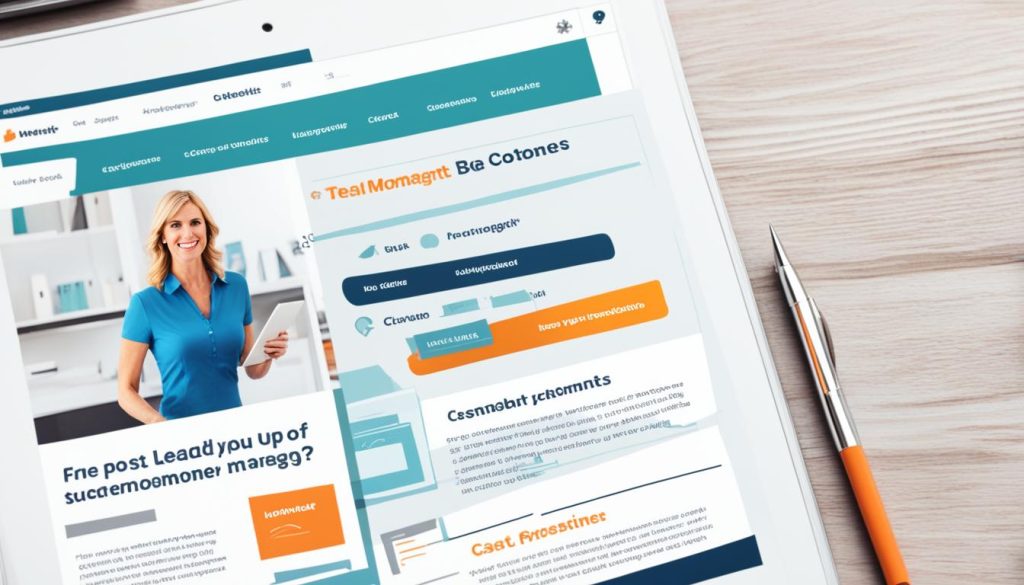Did you know the HubSpot Blog is a top marketing blog in the world? It has been making leads for over ten years. This blog turned readers into potential customers since it started.
The secret to its success is focusing on lead generation. This has helped their business grow every year.
As a blogger, you can use lead generation to grow your audience and build your email list. This guide will share the tactics and techniques the HubSpot team uses. It will help you make your blog successful.
We’ll cover everything you need to know to make your blog a lead-generating machine. Get ready to improve your blogging and see the results you’ve dreamed of.
Auditing Existing Blog Metrics
Before you can effectively generate leads through your blog, it’s crucial to understand your current performance. By auditing your existing blog metrics, you’ll gain valuable insights into your blog’s traffic and lead generation capabilities.
Determine Overall Traffic and Lead Numbers
Start by analyzing your blog’s overall traffic and lead numbers. This will give you a baseline to track your progress and measure the impact of your lead generation strategies. Pay attention to trends in your traffic and lead data, as they can reveal opportunities for improvement.
Calculate Overall Blog Conversion Rate
Next, calculate your blog’s overall conversion rate. This metric shows how effectively your blog is converting visitors into leads. By understanding your current conversion rate, you can identify areas for optimization and set realistic goals for improvement.
Analyze Post-Level Traffic and Conversion Data
Dive deeper into your blog’s performance by analyzing post-level data. Look at the traffic and conversion rates for individual blog posts to identify your top-performing content. This information will help you prioritize your lead generation efforts and allocate resources to the most promising topics and formats.
By thoroughly auditing your blog’s metrics, you’ll gain a clear understanding of your current traffic and lead numbers, blog conversion rate, and post-level data. This foundation will enable you to make informed decisions and develop a strategic plan for turning your blog into a lead generation powerhouse.
Grouping Common Posts into Topic Clusters
For bloggers, organizing content well is key to getting more leads. By putting similar posts together in topic clusters, your blog becomes easier to follow for readers and search engines. This makes it simpler to find what you need.
Categorize Posts into Relevant Topic Tags
Start by categorizing your blog posts with relevant topic tags. Look over your content and match each post with a topic or theme. This makes sure your content is well-organized, helping you to improve your lead generation.
Organize Data by Topic Cluster
After categorizing, group your posts by topic cluster. This means putting posts that are about the same thing together. This creates a clear structure that shows all you offer. It helps you analyze traffic and conversion data better, find areas to improve, and plan better lead generation strategies.
For instance, if your blog is about digital marketing, you might have clusters for “SEO,” “Social Media,” and “Content Marketing.” In each cluster, put related posts together. This makes it clear how your audience interacts with your content and where you can get more leads.
| Topic Cluster | Posts Included | Total Traffic | Lead Generation Potential |
|---|---|---|---|
| SEO |
|
25,000 | High |
| Social Media |
|
18,000 | Medium |
| Content Marketing |
|
22,000 | High |
Organizing your blog like this helps you understand your topic clusters better. It shows where you can improve your post categorization and data organization. This leads to better lead generation efforts.
Determining Content Offer Opportunities
As a smart blogger, you know how content offers can boost leads and help potential customers. By organizing your blog posts into topic clusters, you find content offer opportunities that can bring in lots of leads. This method is key for making the most of your lead generation potential and focusing on the best high-intent topics.
Calculate Lead Generation Potential by Cluster
Begin by looking at the traffic and conversion data for each topic cluster. Find the clusters that get the most engaged visitors and turn them into leads. These top clusters should be your main focus for creating content offers.
Prioritize High-Intent, High-Opportunity Clusters
- Look at the search intent and buyer’s journey stage for each cluster to spot the high-intent areas most likely to convert.
- Check the size and growth potential of each cluster to find the high-opportunity areas that could give the biggest return on your content.
- Focus on the clusters that match both high-intent and high-opportunity criteria. These are the best for making impactful content offers.
By focusing on the most valuable clusters, you can make content offers that speak to your audience and drive leads at every stage of the buyer’s journey. This strategy will boost the effectiveness of your blogging and increase your lead generation potential.
Creating Lead-Generating Content
Creating the right content is key to getting leads for your blog. You need to make lead-generating content that speaks to your audience. This will grab their attention and turn them into valuable leads. There are many content formats you can use to reach this goal.
One great way is to make actionable content like templates, tools, and kits. These give your readers practical steps they can use right away. By offering this lead-generating content, you show you’re an expert in your field and gain trust with your readers.
HubSpot found that their blog audience loves this kind of actionable content. They made templates for their most popular but least converting blog posts. This lets readers see how to use the knowledge they learned. The goal is to share valuable info and make it simple for your audience to act on it.
Creating lead-generating content means keeping it simple and clear. Stay away from complicated ideas and focus on showing your content’s value and relevance. This way, you’ll be more likely to turn your blog visitors into valuable leads.

Offering Valuable Lead Magnets
As a blogger, creating powerful lead magnets can change the game. These are downloadable resources that give a lot of value to your readers for their contact info. By knowing what your audience needs and making high-quality content, you become a go-to expert in your field. This helps you grow your email list.
Identify Target Audience Pain Points
Creating a great lead magnet starts with knowing your audience’s challenges. Do deep research to find out what problems they face. Then, make content that solves those problems. This builds trust and connects you strongly with your audience.
Create High-Quality, Actionable Content
Your lead magnet should be better than your regular blog posts. Make guides, checklists, or reports that give your readers immediate value. Make sure it’s well-researched, easy to understand, and full of advice they can use right away.
Format as Downloadable Resource
After making your lead magnet content, turn it into a downloadable resource that looks good and is easy to use. This could be an ebook, whitepaper, toolkit, or something else that’s easy for your audience to get into. The design should be nice, the layout clean, and the content easy to find and read.
By offering lead magnets that really help your audience, you can grab their attention, grow your email list, and build strong relationships with your readers. Focus on making content that’s truly helpful and changes lives. This will make your lead generation efforts successful over time.
Writing on Unique, Underserved Topics
In the blogging world, it’s hard to stand out. But, writing about unique, underserved topics can help. These topics are not well-covered by others, giving you a chance to be an expert and offer real value.
To find these topics, analyze your industry deeply. Look for topics that are often talked about and those that are ignored. Use keyword research, check out your competitors, and listen to what your audience needs.
- Explore niche or specialized areas within your industry
- Identify emerging trends or topics that are gaining traction
- Address common questions or challenges that your audience is facing
After finding these topics, create content that goes deep and offers practical advice. Aim to give your readers something new and useful, not just the same old info. Being a go-to expert in these areas will grab your audience’s attention and bring in quality leads.
| Unique Topic | Potential Benefits |
|---|---|
| Sustainable Packaging Innovations | Stand out in a crowded industry by addressing an emerging, eco-conscious trend |
| Remote Work Productivity Strategies | Offer valuable insights to a growing audience of remote professionals |
| Personalized Nutrition for Athletes | Establish yourself as an authority in a niche, yet highly valuable, market |
To succeed, keep making top-notch, informative content that meets real needs in your field. Focusing on unique topics will help you get more qualified leads for your business.

Lead generation for bloggers
As a blogger, getting leads is key to growing your online presence. One top strategy is to offer high-quality content that speaks to your audience. By knowing what your readers need and making content for them, you can draw in and turn them into leads.
Bloggers use several tactics to get leads, including:
- Adding compelling calls-to-action (CTAs) in your blog posts to get readers to share their info
- Offering content upgrades, like special guides or checklists, for an email address
- Using lead magnets, such as webinars or ebooks, that offer a lot of value
- Adding interactive content, like quizzes or assessments, to get data from your readers
- Hosting giveaways or contests to make people want to sign up
The secret to great lead generation for bloggers is making content that your audience finds really useful and relevant. By focusing on what they need and giving value first, you can build trust. This helps turn them into valuable leads for your business.
| Lead Generation Tactic | Description | Potential Impact |
|---|---|---|
| Compelling CTAs | Include visually striking and persuasive calls-to-action within blog posts to encourage reader action | Increased lead capture and conversion rates |
| Content Upgrades | Offer exclusive, high-value content in exchange for reader email addresses | Builds email list and nurtures leads |
| Lead Magnets | Provide free, downloadable resources like ebooks, guides, or webinars to attract and capture leads | Establishes authority and generates high-quality leads |
Creating Helpful Blog Content
To get leads from your blog, you need a strategy. Focus on making helpful blog content and keeping content quality high. Know what your audience needs and give them useful, doable advice.
Grouping your blog posts by topic is a smart move. This helps you spot areas for deeper, lead-generating content. By sorting your posts and looking at the data, you can see which topics and formats work best.
- Look at your blog’s past data to find top content and areas to improve.
- Put your content into topic clusters to find spots for better lead magnets and resources.
- Make high-quality, actionable content that solves problems and builds trust in your brand.
Your blog’s success in getting leads depends on its quality and relevance. By offering helpful, informative content, you can show your brand as a trusted expert. This turns more website visitors into valuable leads.

Producing Content for Each Funnel Stage
As a blogger, it’s key to make content for each stage of the buyer’s journey. This helps with lead generation. You should tailor your content to meet the needs and thoughts of your audience at each stage. This guides them smoothly from awareness to purchase.
Top-of-Funnel: Awareness Content
At the top of the funnel, focus on building awareness and grabbing your audience’s attention. This content educates and informs, meeting the awareness content needs of your readers. Examples include blog posts, infographics, and videos that introduce your products or services and address common industry issues.
Middle-of-Funnel: Evaluation Content
As people move through the buyer’s journey, your evaluation content should help them weigh their options. This could be in-depth product comparisons, case studies, or guides that explore the features and benefits of your offerings. The aim is to show how your solutions are the best fit for their problems.
Bottom-of-Funnel: Purchase Content
At the funnel’s end, your purchase content should push your audience towards buying. This might include compelling product demos, testimonials, or special offers. By addressing your audience’s unique needs at each stage, you can nurture leads and boost sales for your blog.
| Funnel Stage | Content Focus | Example Content |
|---|---|---|
| Top-of-Funnel | Awareness Content | Blog posts, infographics, videos |
| Middle-of-Funnel | Evaluation Content | Product comparisons, case studies, detailed guides |
| Bottom-of-Funnel | Purchase Content | Product demos, testimonials, special offers |
Offering Exclusive Gated Content
As a blogger, offering exclusive, gated content is a great way to get more leads. This means giving your readers special or detailed content for their email addresses. This way, you can grow your email list and keep in touch with those leads.
To make this strategy work, you need to create exclusive content that your audience will love. Here are steps to follow:
- Find out what your readers need and want. What would they like to learn or get from you?
- Make content that solves their problems. This could be detailed guides, special interviews, or big reports on your industry.
- Put your content in a format they can download, like a PDF, ebook, or video series.
- Use clear calls-to-action (CTAs) on your blog to ask readers for their email in exchange for the content.
- Keep in touch with the leads you get by sending them more great content and offers. This builds trust and shows you know your stuff.
By giving exclusive gated content, you can grow your email list and be seen as a trusted source. This can lead to more sales, customer loyalty, and a stronger connection with your readers.

| Benefits of Gated Content | Drawbacks of Gated Content |
|---|---|
|
|
Collaborating with Sales Teams
Working with your sales team can boost your lead generation efforts. Sales reps know a lot about what your target audience needs and wants. This knowledge is key to making great lead magnets and content. By working closely with your marketing and sales teams, you can better understand your customers. This helps you make lead generation strategies that work better.
One big plus of working with your sales team is making sure your message is the same in marketing and sales. This makes your brand stronger and brings in better leads. Your sales team can also give you feedback on your content. This helps you make your lead scoring better and find new content ideas.
To improve your marketing and sales team’s work together, follow these steps:
- Have regular meetings to make sure everyone knows the sales team collaboration and lead generation plans.
- Ask your sales team about what problems customers face, what questions they ask, and what objections they have.
- Work together on content that helps the sales team, like sales scripts and product demos.
- Use your sales team’s insights to make your lead scoring system better, focusing on the best leads.
| Benefits of Collaborating with Sales Teams | Impact on Lead Generation |
|---|---|
| Align customer messaging across marketing and sales | Improved lead quality and conversion rates |
| Gain deeper insights into customer pain points and buying behaviors | More effective lead magnets and content |
| Create enablement content to support sales team | Increased sales productivity and efficiency |
| Refine lead scoring system for better lead prioritization | Higher-quality leads entering the sales funnel |
Working closely with your sales team brings valuable insights and better lead generation strategies. This partnership can really help your business grow. So, team up and see your lead generation efforts take off.
Providing Content Upgrades
As a smart blogger, offering content upgrades is a great way to get more leads. These are special resources you give to readers who share their contact info. Content upgrades can really help you get more leads and turn them into customers.
Think about making downloadable lists, templates, or detailed guides that match your blog topics. These upgrades add more value for your readers, making them want to give you their email. Then, you can keep in touch and build trust with them, showing you’re an expert in your field.
- Find blog posts that could use a content upgrade
- Make resources that solve your readers’ problems
- Show the upgrades in your blog posts with strong calls-to-action
- Use email capture tools like lead generation forms to get subscriber info
- Keep your new leads interested with personalized emails and more content
Adding content upgrades to your blog can turn it into a lead-generating powerhouse. It grabs the attention of your most interested readers, gets their contact info, and grows your email list. This leads to more qualified leads for your business.

Optimizing for User Intent
As a savvy blogger, it’s key to know what your readers are looking for. This knowledge helps you make content that turns readers into leads. By focusing on high-intent keywords and meeting your audience’s needs, you can increase your lead generation.
First, do deep research to understand your audience’s intent. This tells you what kind of content they want, like information, directions, or something to buy. Making your content match their search intent is crucial to grab their attention and turn them into leads.
- Prioritize high-intent keywords: Create content for keywords with a clear goal, like “buy,” “subscribe,” or “download.”
- Address specific pain points: Look at your audience’s problems and make content that solves them.
- Optimize for search intent: Make sure your content’s structure, format, and tone match what users expect to find.
| Search Intent | Content Type | Example |
|---|---|---|
| Informational | Educational articles, how-to guides | “How to optimize blog pages for lead generation” |
| Navigational | Product or service pages | “Letterdrop blog optimization services” |
| Transactional | Sales pages, signup forms | “Subscribe to our lead generation newsletter” |
By matching your content with what users are looking for, you’ll get more high-quality leads from your blog.
Using Interactive Content
As a savvy blogger, you know how key it is to grab your audience’s attention and build strong connections with potential leads. Using interactive content in your blog posts is a great way to do this. Elements like quizzes, polls, or calculators can make your readers more engaged and give you valuable insights for lead generation.
Interactive experiences let your audience give their contact info for personalized tips or special content. This method not only grows your lead list but also helps you connect with your audience over time.
- Quizzes: Make quizzes that are both fun and informative, giving readers personalized results. This keeps them interested and lets you get their email for their quiz results.
- Polls: Use polls to get feedback from your audience with interesting questions or surveys. This info helps you understand what your readers like and what they need, guiding your content and lead generation.
- Calculators: Offer calculators that give your readers useful insights. For instance, a budget calculator or a lead generation ROI calculator can grab your readers’ attention and get their contact info.
Adding these interactive elements to your blog makes the user experience better and helps you get high-quality leads. These leads can be nurtured and turned into loyal customers.
| Interactive Content Type | Benefits for Lead Generation |
|---|---|
| Quizzes | Capture email addresses in exchange for personalized results, gain insights into audience interests |
| Polls | Gather valuable feedback from readers, understand pain points and content preferences |
| Calculators | Provide useful, actionable insights to readers, collect contact information for lead nurturing |
Including Compelling Calls-to-Action
To boost your blog’s lead generation, use calls-to-action (CTAs) that grab your audience’s attention. These CTAs should be eye-catching, show the value of your offer, and make it easy for readers to act. By adding strong CTAs in your content, you can lead your audience to become valuable leads for your business.
Your CTAs are key to your lead generation success. Place them where they’re most visible and impactful. They could be for a free ebook, webinar sign-up, or consultation request. Make sure they’re interesting and clear, guiding readers to take action.
Creating calls-to-action that speak to your audience’s needs can unlock your lead generation strategy’s full potential. Try out different CTA placements, messages, and designs to see what works best for your blog and audience.

